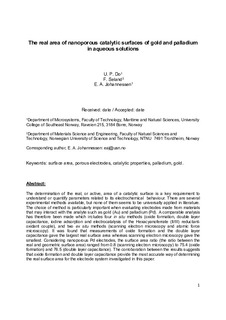| dc.contributor.author | Do, Uyen Phuong | |
| dc.contributor.author | Seland, Frode | |
| dc.contributor.author | Johannessen, Erik Andrew | |
| dc.date.accessioned | 2019-03-04T08:57:22Z | |
| dc.date.available | 2019-03-04T08:57:22Z | |
| dc.date.created | 2018-06-28T14:48:29Z | |
| dc.date.issued | 2018 | |
| dc.identifier.citation | Journal of the Electrochemical Society. 2018, 165 (5), H219-H228. | nb_NO |
| dc.identifier.issn | 0013-4651 | |
| dc.identifier.uri | http://hdl.handle.net/11250/2588391 | |
| dc.description.abstract | The determination of the real, or active, area of a catalytic surface is a key requirement to understand or quantify parameters related to its electrochemical behavior. There are several experimental methods available, but none of them seems to be universally applied in literature. The choice of method is particularly important when evaluating electrodes made from materials that may interact with the analyte such as gold (Au) and palladium (Pd). A comparable analysis has therefore been made which includes four in situ methods (oxide formation, double layer capacitance, iodine adsorption and electrocatalysis of the Hexacyanoferrate (II/III) reductant-oxidant couple), and two ex situ methods (scanning electron microscopy and atomic force microscopy). It was found that measurements of oxide formation and the double layer capacitance gave the largest real surface area whereas scanning electron microscopy gave the smallest. Considering nanoporous Pd electrodes, the surface area ratio (the ratio between the real and geometric surface area) ranged from 0.8 (scanning electron microscopy) to 75.4 (oxide formation) and 76.5 (double layer capacitance). The corroboration between the results suggests that oxide formation and double layer capacitance provide the most accurate way of determining the real surface area for the electrode system investigated in this paper. | nb_NO |
| dc.language.iso | eng | nb_NO |
| dc.publisher | Electrochemical Society | nb_NO |
| dc.title | The real area of nanoporous catalytic surfaces of gold and palladium in aqueous solutions | nb_NO |
| dc.type | Journal article | nb_NO |
| dc.type | Peer reviewed | nb_NO |
| dc.description.version | acceptedVersion | nb_NO |
| dc.source.pagenumber | H219-H228 | nb_NO |
| dc.source.volume | 165 | nb_NO |
| dc.source.journal | Journal of the Electrochemical Society | nb_NO |
| dc.source.issue | 5 | nb_NO |
| dc.identifier.doi | 10.1149/2.0341805jes | |
| dc.identifier.cristin | 1594552 | |
| dc.relation.project | Norges forskningsråd: 245963 | nb_NO |
| dc.description.localcode | © 2018. This is the authors' accepted and refereed manuscript to the article. The final authenticated version is available online at: http://dx.doi.org/10.1149/2.0341805jes | nb_NO |
| cristin.unitcode | 194,66,35,0 | |
| cristin.unitname | Institutt for materialteknologi | |
| cristin.ispublished | true | |
| cristin.fulltext | preprint | |
| cristin.fulltext | original | |
| cristin.qualitycode | 2 | |
